Classroom Choice Boards are a Natural Fit for Use with Dry Erase Walls
For teachers, encouraging student engagement is both the most essential and most challenging aspect of creating classroom activities. How is it possible to engage a class of 30 students, all with unique personalities and learning styles, by assigning a single activity? The trick is not to assign just one activity but instead to offer a variety of activities to your students through the use of a choice board that is easily created on your dry erase painted wall.
A choice board is a type of graphic organizer or visual support containing objects, pictures, photographs, line drawings, and/or textual content that students can use to express what activities, tasks, or items they want to pursue in a lesson. The collection of activities on the choice board provides students with options to choose from in order to obtain the same content knowledge while using different skills. At least two options at a time may be presented for students to select from, with nine choices being the number used by most teachers.
Benefits of Using Choice Boards in the Classroom
By employing the choice board teaching strategy, you empower your class members to decide on how they want to learn about a given subject or concept, prompting them to become more conscientious, accountable, and self-reliant with their education. The method also allows learners to take part in the chosen projects at their own speed and in their own style, thus improving their satisfaction with what they learn. In addition, the boards are useful for teachers, as they help in discovering and using students’ interests and preferences to inspire them to learn and feel committed to their school work.
Choice boards stimulate students’ enthusiasm and engagement in classroom activities while at the same time using “differentiated instruction”; that is, customized teaching that meets students’ personal needs and, in turn, encourages learning.
Why Should You Use Choice Boards in Your Classroom?
Ideally, teachers are always able to offer students ample opportunities to practice and master the concepts they’re taught in class. However, structuring and monitoring students’ learning activities can be difficult, as teachers need to consider the requirements of differentiated instruction and children’s diverse learning styles while at the same time ensuring that course content is both exciting and challenging.
Through the use of choice boards, teachers can simplify the lesson-planning process and more easily address students’ individual learning needs. The strategy is simple to design and apply and can help to support learning, as well as enhance students’ enthusiasm and participation in class activities.
How Choice Boards may be Put into Practice with Dry Erase Walls
Choice boards can easily be used in conjunction with premium dry erase painted walls to differentiate instruction, improve students’ interest in learning, and enhance their academic performance. Being graphic organizers composed of several equal-sized squares containing different activities, choice boards are easy to create on the vast open surface of a dry erase wall with washi tape, electrical tape, or masking tape and a yardstick or ruler as a guide.
The activities posted on the boards help students to understand or practice a basic educational concept while giving them choices as to what they want to learn. Students may be allowed to select one or more of the activities to complete at one time, moving from one task to another in either a systematic or random order. The activities can be assigned to be completed in a single class session or over a more extended period.
For instance, if you’re teaching about the way a bill passes through the US Congress to become a law, students can decide to read an article on the subject, watch a video, or participate in a simulation that you conduct with a small group. Afterward, the students can show that they learned the content by writing an in-depth summary, creating a diagram or an infographic, or putting on a performance that demonstrates how the process works. Through this approach, students with varying interests and learning styles will be naturally drawn to different types of activities. And each student will appreciate that they were allowed to use the skills they wanted to use, or at least be able to say they had an opportunity to choose their activities.
The Design of Choice Boards Should Focus on an Academic Subject or Goal
A choice board should be focused on a specific subject or educational objective, with each activity on the board designed to encourage the learning, practice, or mastery of that subject. The steps involved in creating a choice board are as follows:
A. Determine the main concept or learning goal that the students need to master.
B. Establish the students’ interests, inclinations, and levels of preparedness.
C. Design the activities such that the board gives students an array of media or means for learning the concept or achieving the objective.
D. Arrange the activities according to differing levels of complexity or an increasing order of difficulty.
E. Include additional instructions on completing each task and on whether students should complete the tasks individually or in groups.
F. Add one square labeled “Free Choice” that allows students to devise and carry out an activity of their own choosing.
Here are some additional tips for creating your choice board so as to implement differentiated learning and offer your students some variety in completing their activities:
1. When creating the board, be sure to include items that cater to your students’ individual learning styles, such as visual, read-write, auditory, and kinesthetic.
2. Boards can be generated for weekly academic tasks, for homework assignments, for class projects, and even for assessments.
3. An extra credit space may be included to help motivate students in their learning.
The use of choice boards in the classroom helps to boost student incentive, engagement, and learning by empowering them to work to their highest potential and by addressing their personal learning styles and desire for freedom of choice.
Styles of Choice Boards to Consider
When creating choice boards for your classroom, two main styles may be considered: tic-tac-toe and menu.
The Tic-Tac-Toe Choice Board Made with Dry Erase Paint
Tic-Tac-Toe: Here, the students are offered the chance to choose three different activities aligned in a horizontal, vertical, or diagonal row on a board with a 3 X 3 box configuration, as in the game of tic-tac-toe. In this approach, the “free choice” square can be placed in the middle.
The tic-tac-toe choice board is ideal for use in earlier grades but can be applied in other grades as well. The activities should address different learning styles, with each one maintaining some degree of rigor. Generally speaking, an easier activity is in the same horizontal, vertical, or diagonal row as a more difficult one. Many tic-tac-toe choice board templates are accessible online, or you can create your own.
The Menu Choice Board Made with Dry Erase Paint
Menu: This style of choice board is excellent for older students. In boards with the menu design, students are provided with a number of sections, and they select one activity from each section, as in ordering from a restaurant menu — an appetizer, an entree, and a dessert.
To more effectively engage students, it’s best to give themes to your menus that relate to issues or topics the students care about, such as the need to fill positions on a sports team, collect objects to build a set, or play the part of a superhero trying to build a dream team. With older students, this approach can foster greater engagement in the choice board activities.
When a theme that resonates with your students runs through all of the items on a choice board, the students have the chance to select based on the kinds of activities they like, and they also become more interested in their projects. One way to get ideas for themes is to listen to what your students talk about in the classroom or the lunch room, and then use these topics on your choice boards.
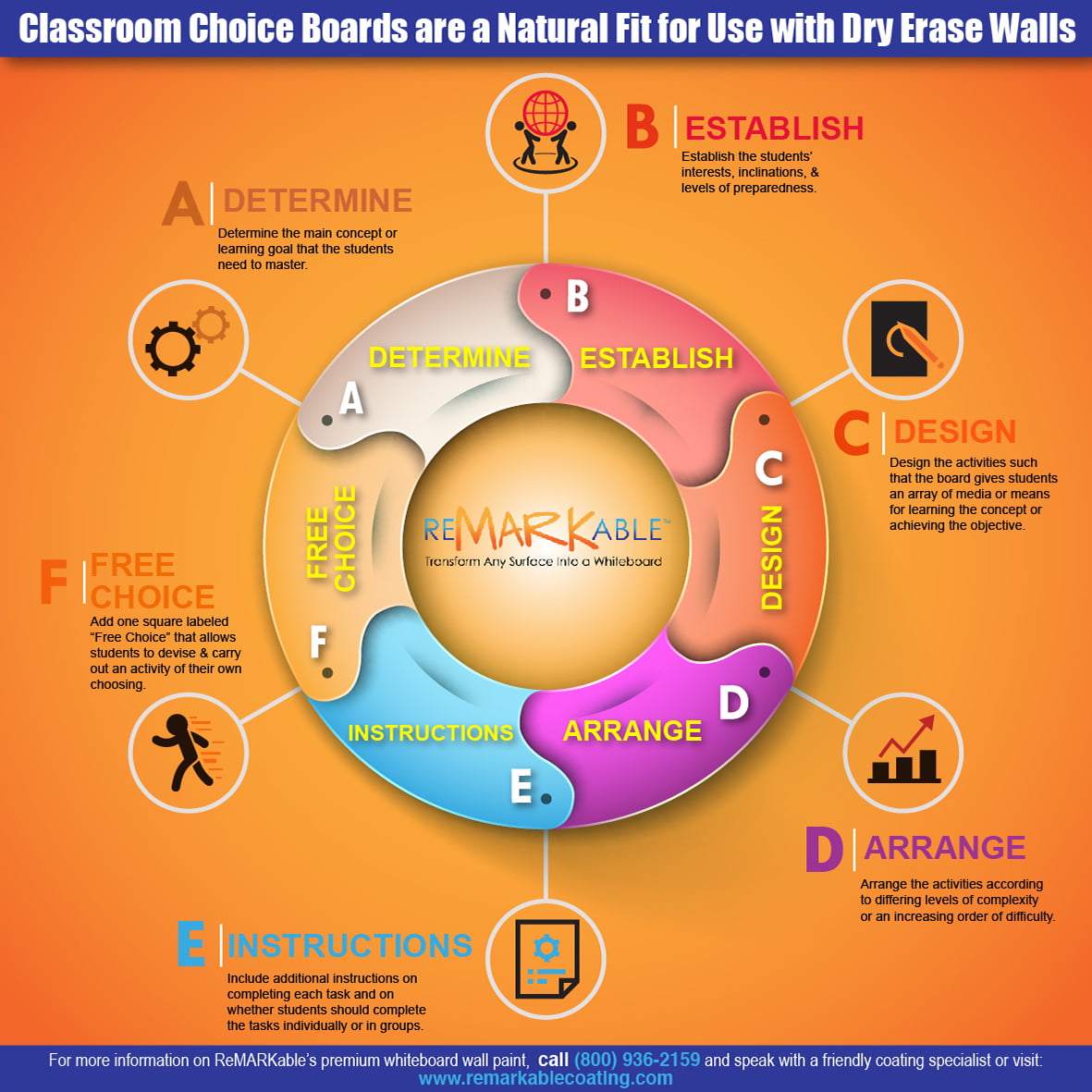

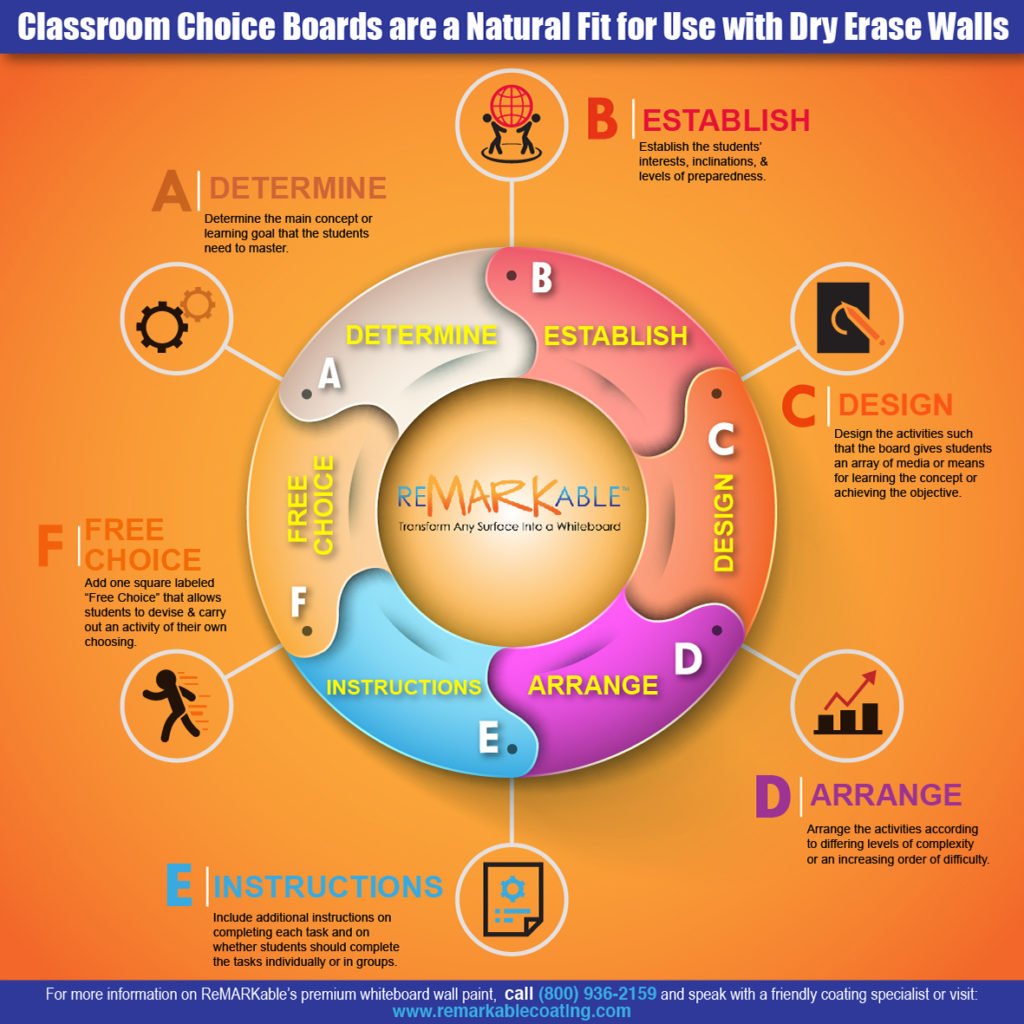
























































































![ReMARKable’s Winter Sale is Here! [25% Off + Free Shipping]](https://www.remarkablecoating.com/wp-content/uploads/2018/01/Red-Tag-Winter-Fashion-Facebook-Post-1-440x264.png)















![Drive Your Organization Into Openness and Watch it Expand [20% Off Whiteboard Paint]](https://www.remarkablecoating.com/wp-content/uploads/2016/04/Drive-Your-Organization-Into-Openness-and-Watch-It-Expand.-1-440x264.jpg)

![30% Off St Patrick’s Day Sale! [Details Inside]](https://www.remarkablecoating.com/wp-content/uploads/2016/03/Glorious-1-440x264.png)


![Giant Leaps Forward Require Big Spaces. [Leap Year Sale Event!]](https://www.remarkablecoating.com/wp-content/uploads/2016/02/Giant-Leaps-ForwardRequire-Big-Spaces-440x264.jpg)

















![ReMARKable Summer Sale 2018 [28% Off Whiteboard Paint]](https://www.remarkablecoating.com/wp-content/uploads/2018/06/Blue-Simple-Line-Beach-Facebook-Post-1-440x264.png)










































































































































































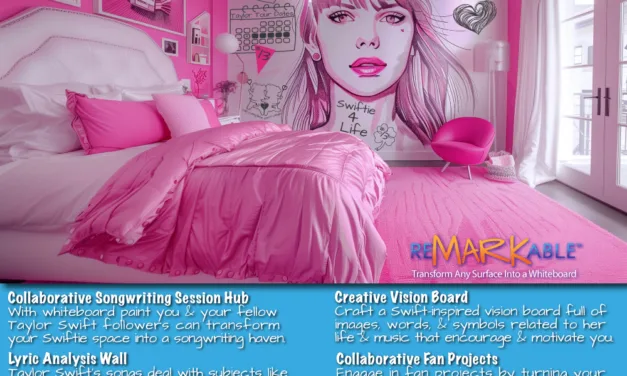

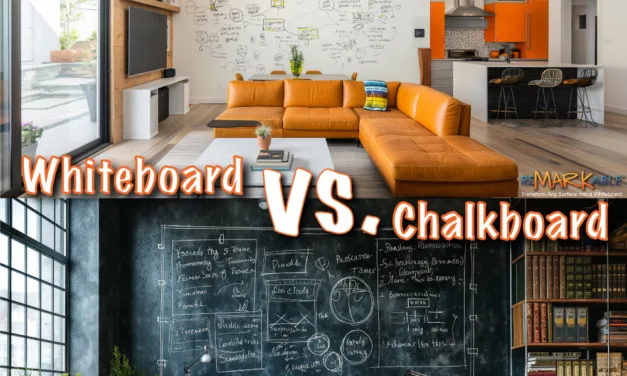








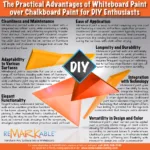
0 Comments